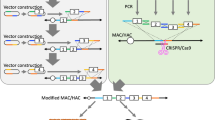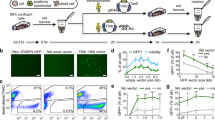Abstract
Artificial chromosomes (ACs) are highly promising vectors for use in gene therapy applications. They are able to maintain expression of genomic-sized exogenous transgenes within target cells, without integrating into the host genome. Although these vectors have huge potential and benefits when compared against normal expression constructs, they are highly complex, technically challenging to construct and diffcult to deliver to target cells. This review focuses on the current progress in the field of ACs and discusses the recent advances in purification, construction, delivery and potential new molecular therapies.
This is a preview of subscription content, access via your institution
Access options
Subscribe to this journal
Receive 12 print issues and online access
$259.00 per year
only $21.58 per issue
Buy this article
- Purchase on Springer Link
- Instant access to full article PDF
Prices may be subject to local taxes which are calculated during checkout



Similar content being viewed by others
References
Duncan A, Hadlaczky G . Chromosomal engineering. Curr Opin Biotechnol 2007; 18: 420–424.
Lufino MM, Edser PA, Wade-Martins R . Advances in high-capacity extrachromosomal vector technology: episomal maintenance, vector delivery, and transgene expression. Mol Ther 2008; 16: 1525–1538.
Ren X, Tahimic CG, Katoh M, Kurimasa A, Inoue T, Oshimura M . Human artificial chromosome vectors meet stem cells: new prospects for gene delivery. Stem Cell Rev 2006; 2: 43–50.
Monaco ZL, Moralli D . Progress in artificial chromosome technology. Biochem Soc Trans 2006; 34: 324–327.
Heaney JD, Bronson SK . Artificial chromosome-based transgenes in the study of genome function. Mamm Genome 2006; 17: 791–807.
Peterson KR . Preparation of intact yeast artificial chromosome DNA for transgenesis of mice. Nat Protoc 2007; 2: 3009–3015.
Leem SH, Yoon YH, Kim SI, Larionov V . Purification of circular YACs from yeast cells for DNA sequencing. Genome 2008; 51: 155–158.
Kouprina N, Larionov V . Selective isolation of genomic loci from complex genomes by transformation-associated recombination cloning in the yeast Saccharomyces cerevisiae. Nat Protoc 2008; 3: 371–377.
Zhou F, Li Q, Gao SJ . A sequence-independent in vitro transposon-based strategy for efficient cloning of genomes of large DNA viruses as bacterial artificial chromosomes. Nucleic Acids Res 2008; 37: e2 (doi:10.1093/nar/gkn890).
Macnab S, White R, Hiscox J, Whitehouse A . Production of an infectious Herpesvirus saimiri-based episomally maintained amplicon system. J Biotechnol 2008; 134: 287–296.
Hibbitt OC, Harbottle RP, Waddington SN, Bursill CA, Coutelle C, Channon KM et al. Delivery and long-term expression of a 135 kb LDLR genomic DNA locus in vivo by hydrodynamic tail vein injection. J Gene Med 2007; 9: 488–497.
Griffiths RA, Boyne JR, Whitehouse A . Herpesvirus saimiri-based gene delivery vectors. Curr Gene Ther 2006; 6: 1–15.
Grant KG, Krisky DM, Ataai MM, Glorioso III JC . Engineering cell lines for production of replication defective HSV-1 gene therapy vectors. Biotechnol Bioeng 2008; 102: 1087–1097.
Moralli D, Simpson KM, Wade-Martins R, Monaco ZL . A novel human artificial chromosome gene expression system using herpes simplex virus type 1 vectors. EMBO Rep 2006; 7: 911–918.
Jiao W, Lin HM, Timmons J, Nagaich AK, Ng SW, Misteli T et al. E2F-dependent repression of topoisomerase II regulates heterochromatin formation and apoptosis in cells with melanoma-prone mutation. Cancer Res 2005; 65: 4067–4077.
Ooi YS, Warburton PE, Ravin NV, Narayanan K . Recombineering linear DNA that replicate stably in E. coli. Plasmid 2008; 59: 63–71.
Roguev A, Krogan NJ . BAC to the future: functional genomics in mammals. Nat Methods 2008; 5: 383–384.
Poser I, Sarov M, Hutchins JR, Heriche JK, Toyoda Y, Pozniakovsky A et al. BAC TransgeneOmics: a high-throughput method for exploration of protein function in mammals. Nat Methods 2008; 5: 409–415.
Kotzamanis G, Abdulrazzak H, Gifford-Garner J, Haussecker PL, Cheung W, Grillot-Courvalin C et al. CFTR expression from a BAC carrying the complete human gene and associated regulatory elements. J Cell Mol Med 2008; 24 (Postprint; 10.1111/j.1582-4934.2008.00433.x).
Hibbitt OC, Wade-Martins R . Delivery of large genomic DNA inserts >100 kb using HSV-1 amplicons. Curr Gene Ther 2006; 6: 325–336.
Gomez-Sebastian S, Gimenez-Cassina A, Diaz-Nido J, Lim F, Wade-Martins R . Infectious delivery and expression of a 135 kb human FRDA genomic DNA locus complements Friedreich′s ataxia deficiency in human cells. Mol Ther 2007; 15: 248–254.
Shitara S, Kakeda M, Nagata K, Hiratsuka M, Sano A, Osawa K et al. Telomerase-mediated life-span extension of human primary fibroblasts by human artificial chromosome (HAC) vector. Biochem Biophys Res Commun 2008; 369: 807–811.
Hoshiya H, Kazuki Y, Abe S, Takiguchi M, Kajitani N, Watanabe Y et al. A highly stable and nonintegrated human artificial chromosome (HAC) containing the 2.4 MB entire human dystriophin gene. Mol Ther 2008; 17: 309–317.
Hoen P, de Meijer E, Boer J, Vossen R, Turk R, Maatman R et al. Generation and characterization of transgenic mice with the full-length human DMD gene. J Biol Chem 2008; 283: 5899–5907.
Kinoshita Y, Kamitani H, Mamun M, Wasita B, Kazuki Y, Hiratsuka M et al. A gene delivery system with a human artificail chromosome vector based on migration of mesenchymal stem cells towards human glioblastoma HTB14 cells. Neurol Res 2009 (doi:10.1179/174313209X455718).
Katona R, Sinko I, Hollo G, Szucs K, Praznoszky T, Kereso J et al. A combined artificialchromosome-stem cell therapy method in a model experiment aimed at the treatment of Krabbe's disease in the Twitcher mouse. Cell Mol Life Sci 2008; 65: 3830–3838.
Kazuki Y, Hoshiya H, Kai Y, Abe S, Takiguchi M, Osaki M et al. Correction of a genetic defect in multipotent germline stem cells using a human artifical chromosome. Gene Therapy 2008; 15: 617–624.
Author information
Authors and Affiliations
Corresponding author
Rights and permissions
About this article
Cite this article
Macnab, S., Whitehouse, A. Progress and prospects: human artificial chromosomes. Gene Ther 16, 1180–1188 (2009). https://doi.org/10.1038/gt.2009.102
Received:
Revised:
Accepted:
Published:
Issue Date:
DOI: https://doi.org/10.1038/gt.2009.102
Keywords
This article is cited by
-
Enhanced chromosome extraction from cells using a pinched flow microfluidic device
Biomedical Microdevices (2020)
-
Genetic and epigenetic effects on centromere establishment
Chromosoma (2020)
-
De novo formed satellite DNA-based mammalian artificial chromosomes and their possible applications
Chromosome Research (2015)
-
Chromosomes in the flow to simplify genome analysis
Functional & Integrative Genomics (2012)



